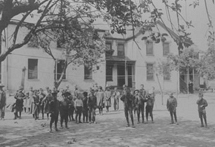The Orphanage: Caring for the Kids
(Editor’s note: This article originally appeared in the Diocese of Salt Lake City’s website’s ‘From the Archives’ section. Reprinted with permission.) Although he was the son of poor Irish immigrants and possessed only a grammar school education, Thomas Kearns became one of Utah’s wealthiest and most influential public figures. Like many of Utah’s earliest millionaires, Kearns made his fortune from the territory’s rich silver deposits. In 1883, with his partners John Judge and David Keith, he developed the Silver King mine in Park City, which became one of the biggest producers in Utah history. Eventually he served as U.S. senator and publisher of both the Salt Lake Tribune and the Salt Lake Telegram newspapers before his death in 1918. Mining is a dangerous occupation, and accidents in Kearns’ mine and many others left families without a breadwinner and children without parents. Moved by compassion for those orphans, the Holy Cross Sisters opened an orphanage in 1891 in a two-story adobe building on First South and Third East. The building was only a block south of the planned site of the Cathedral of the Madeleine, and in fact had been utilized as a rectory by Father Lawrence Scanlan and other priests who served the growing Catholic population in Saint Mary’s church one block in another direction, west of the future Cathedral, on Second East. When the present rectory was erected and Salt Lake City became a diocese in 1891, Bishop Scanlan gave the building to the orphans. But the orphan population kept growing, necessitating additions to the building on two separate occasions. In 1898, Bishop Scanlan accepted an option on a 15-acre parcel extending to the south of Twenty-first South, with the idea of building an expanded orphanage which would have the capability of producing much of its own food on its rich farmland. The following year, Mrs. Kearns gave Bishop Scanlan $50,000 for construction of the orphanage, which was designed by Carl M. Neuhausen, architect of the Cathedral and Holy Cross Hospital, and opened in 1900. At about that time, the orphanage had a population in excess of 100 children. When wealthy miner and merchant Patrick Phelan died in 1901, he left a substantial endowment to the orphanage. St. Ann Orphanage was not only a living facility, but a school as well, educating children from the ages of 5 to 15. Other neighborhood children enrolled too, to take advantage of the excellent nearby school. In 1926 there were 36 resident boys and 30 resident girls enrolled, as well as 50 non-resident children. Nowadays the term "orphanage" evokes mental images of Dickensian hellholes of squalor, starvation, and abuse. St. Ann was nothing of the kind. Surviving photographs show clean, well-clothed children apparently happy and thriving on what was then a rural acreage. Deacon Silvio Mayo, who worked at the orphanage while a student at Judge Memorial Catholic High School, speaks with high praise of the quality and quantity of the food. But social welfare practices in the United States began taking a different turn in the mid-twentieth century, particularly after the creation of government agencies that could do what privately endowed programs could not. Like the great settlement houses in the cities, orphanages like St. Ann yielded to more modern ways. Between 1953 and 1955 St. Ann made a transition from orphanage to school, which it remains today under the auspices of St. Ann Parish.
© Copyright 2024 The Diocese of Salt Lake City. All rights reserved.



Stay Connected With Us